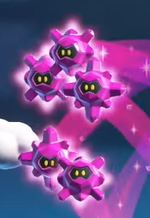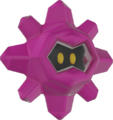Sugarstar
This article is about a subject in an upcoming or recently released game. When the game is released, or more information about this subject is found, this article may need major rewriting.
This notice should be removed after a month has passed since the game was first released.
| Sugarstar | |
|---|---|
 Multiple magenta Sugarstars | |
| First appearance | Super Mario Bros. Wonder (2023) |
Sugarstars are shiny, geometric enemies from Super Mario Bros. Wonder. They are first introduced in the level The Sugarstar Trial: Across the Night Sky, a level where many of them appear. They fly around in a circular pattern, often forming together to make a wave-like motion. They come in both magenta and green, with magenta Sugarstars being speedy while green ones are much slower. When one gets hit, instead of being defeated entirely, it regenerates its crystal body after a few seconds. They also emit a sparkly trail as they soar.
The design and Japanese name of the Sugarstars are based on the Japanese sugar candy konpeitō, much like Star Bits.
Gallery
Names in other languages
| Language | Name | Meaning | Notes |
|---|---|---|---|
| Japanese | コンペイ[?] Konpei |
Clipped form of「金平糖」(konpeitō, a Japanese sugar candy) | |
| Chinese | 金平怪[?] Jīnpíng Guài |
"Konpei" Monster | |
| German | Schwärmer[?] | Agentive form of "Schwärmen" (to swarm) | |
| Italian | Caramellotto[?] | From "caramella" (candy) and the masculine diminutive suffix "-otto" | |
| Korean | 사탕바위와[?] Satangbawiwa |
From "砂糖" (satang, "candy" in Sino-Korean) and "바위" (bawi, rock) | |
| Portuguese | Confeitino[?] | From "confeito" (confectionery) and masculine diminutive suffix "-ino" | |
| Russian | Сладкоежами[?] Sladkoyezhami |
? | |
| Spanish (NOA) | Confito[?] | Masculine form of "confitar" (confectionery, synonym for "candy") | |
| Spanish (NOE) | Anisiris[?] | Portmanteau of "anís" (anise) and "arco iris" (rainbow) |


